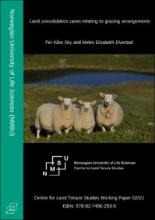Land Library
Welcome to the Land Portal Library. Explore our vast collection of open-access resources (over 74,000) including reports, journal articles, research papers, peer-reviewed publications, legal documents, videos and much more.
/ library resources
Showing items 1 through 9 of 464.Land consolidation courts deal with cases where the relationship between holders of grazing rights needs be regulated, but also where the rights holders are competing with other potential land uses, such as building holiday cabins, forestry, hunting, etc.
In most countries, land consolidation was first introduced in rural areas, with legislation suitable for urban areas being drafted at a later date. This is also true of Norway. The first evidence of urban competency in the legislation is found in the Land Consolidation Act from 1950.
Landscapes changes are a result of a wide range of interactions between actors and driving forces (DFs).
The growing awareness of the negative impact of agriculture on the natural environment creates social expectation towards the reduction of this impact through the pro-environmental activities of farmers.
Notwithstanding their crucial role in ecosystem functionality, large carnivores generally entail economic costs to hunters due to competition for the same prey. This cost could potentially vary depending on carnivore density and the game hunting values at stake.
Although still at incipient stages in most areas, agricultural land markets in sub-Saharan Africa (SSA) are growing rapidly. While the literature on the region’s land markets is expanding, there has been little attention thus far paid to the drivers of land rental prices.
National parks and other forms of protection ensure the natural values in the European Union. However, a significant part of protected areas is under agricultural cultivation, and the two sectors have been kind of opponents to each other for a long time.
It is essential to understand how urban plans affect urban growth patterns in order to improve current urban planning and management systems.
Contemporary discourses on customary land tenure in Africa, and South Africa in particular, have emphasized the socially embedded and flexible nature of customary land rights, recognising these as inherently more ‘pro-poor’ than individual titling.



